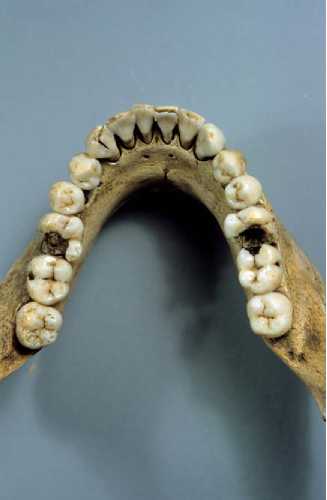One of the important challenges of studying the transition from foraging to farming has been documenting the timing and nature of this transition. Traditionally, archaeologists have studied palaeobotanical, faunal, and artifactual evidence to document the types of

Figure 1 Carious lesions in the mandibular molars of a farmer from North Carolina.
? Southeast farmers ¦ Southwest farmers
? California fisherpeople

Food resources available and presumably consumed by people at a particular locale. Bioarchaeology adds a different dimension to the study of diet and dietary change through the analysis of the biological impacts different subsistence regimes had on the teeth and bones of ancient practitioners (see Osteological Methods; Paleopathology). Dental indicators and bone chemistry are the most important lines of skeletal evidence for diet. These are discussed in greater detail below.
Reconstructing Diet from Dental Indicators
A number of dental indicators are used to gain insights into the nature of foods consumed. These include dental disease (dental caries, periodontal disease, alveolar abscesses, and antemortem tooth loss), tooth wear, chipping, dental calculus (plaque), and patterns of dental occlusion and associated craniofacial robusticity. These are not necessarily mutually exclusive and indeed are often interrelated. This discussion focuses on worldwide patterns of three indicators that have proven particularly useful for assessing changes in diet: dental disease, dental wear (attrition), and craniofacial morphology.
Dental caries is a disease process caused by the bacterial fermentation of dietary carbohydrates, which produces acids that erode tooth enamel (Figure 1). Because caries-causing oral bacteria such as Streptococcus mutans thrive on carbohydrates, dental caries is more prevalent in individuals and populations consuming carbohydrate-rich foods (Figure 2). Such foods tend to be more heavily processed and thus do not have the cleansing properties of greens and other fresh foods that require heavy chewing, which also contributes to dental disease. Cereal food production in particular is a primary factor in declining dental health with the transition to agriculture; grains are valuable cultigens because they store well, but properties such as hard texture and low water content that enhance storage result in the need for hulling, grinding, and/or cooking before consumption. Highly processed foods stick to the teeth and feed the oral bacteria such as S. mutans that adhere to tooth surfaces.
Although changes in dental disease with the advent of agriculture are far from uniform, a general trend toward increasing dental caries and antemortem tooth loss is evident in both New and Old World contexts. In the New World, maize is the most important cause of increasing rates of dental disease due its relatively high sugar content, and observed changes in dental health throughout the Americas are often marked when people make the shift from foraging to maize farming. For example, this pattern of declining
Figure 2 Comparison of dental caries rates in foragers and farmers.
Dental health with agricultural intensification has been documented in northern Chile and coastal Peru in South America, in Mesoamerica, and in various regions of North America including the Southwest, Great Basin, Great Plains, and Eastern Woodlands. Hence, an increase in dental disease has often been used as a proxy measure of corn consumption and the shift to maize agriculture in New World contexts.
In the Old World, the agricultural base was often more diversified, potentially including several grains or legumes and domesticated animals; the consequences to dental health were correspondingly more varied. In the Levant, for example, there is little evidence for increasing prevalence of dental caries at the Neolithic transition, though a considerable decline in dental health is evident later in the agricultural sequence. On the other hand, when prehistoric farmers (wheat, rice, barley) of western India made the reverse transition to foraging, there was a substantial reduction in dental caries prevalence, evidence for the cariogenic nature of the agricultural diet there. Overall, dental health decline is more prominent than stasis or improvement in the Old World, but the changes are not uniform or generally as severe as those documented in the New World.
It should also be noted that other diets can also result in an increase in dental disease, so it is important to seek corroborating evidence that agricultural products were responsible. For example, on the offshore islands of the Santa Barbara Channel, California, a region where agriculture never took hold prehistorically, early inhabitants had relatively high rates of dental caries that subsequently declined through time. It is uncertain what led to dental disease in this environment, but one possibility is the consumption of sugary roots and tubers, a hypothesis supported by the presence of digging apparatus in archaeological sites of the time. In Portugal, foragers had fairly comparable rates of dental disease relative to later agriculturalists, probably due to the consumption of cariogenic wild foods such as sticky fruits and honey. These cautionary tales illustrate the importance of multiple lines of evidence in reconstructing diet and identifying agriculture from visual examination of teeth.
Unlike dental caries, dental wear shows a decline in most world regions with the transition to agriculture. This is because processed foods are softer and require less chewing, which reduces the loss of enamel on the occlusal surfaces of teeth, although use of sandstone mortars and metates for processing grain crops may introduce grit into these staple foods and lead to increased wear. The form of dental wear also tends to differ between foragers and farmers: the worn molars of foragers tend to be flat, whereas those of agriculturalists tend to be angled and often have a cupped appearance attributed to the consumption of softer foods. This change in degree and type of wear is evident at the foraging-farming transition in the southern Levant, for example, although wear rates tend to track the stage of transition and earlier farmers show more comparable wear to foragers than later farmers.
Other dental signs of an agricultural diet observed in skeletal series worldwide include a reduction in the size of the jaw and concomitant malocclusion of teeth. Chewing hard-textured foods tends to stimulate growth of the jaw bones, producing jaws that can accommodate the permanent teeth. Soft-textured foods require little chewing, on the other hand, resulting in narrower dental arches, tooth crowding, and misalignment of teeth. In consequence, facial form tends to change with the transition to agriculture, with agriculturalists having less robust facial features than their forager antecedents. This pattern is evident in the Eastern Woodlands of North America, in the Balkans region of central Europe, in the Nile Valley of Africa, and in the southern Levant region of the Middle East, where a reduction in craniofacial robus-ticity is evident from the Natufian to Neolithic transition with the adoption of agropastoralism.
Bone Chemistry
Studies of bone chemistry have added an important dimension to the study of diet and dietary transitions because they provide an independent line of evidence and document the relative importance of certain types of food for individuals and populations. Stable isotopes of several elements (carbon, nitrogen, strontium), as well as a number of trace elements (e. g., barium, calcium, strontium, zinc), have been used to track changes in diet. These elements are important components of the foods we consume and are incorporated into our bone tissues during normal bone growth and maintenance.
The two elements that have proved to be most useful in bone chemistry research on dietary transitions and agricultural origins are carbon and nitrogen. Each element has two stable forms (stable isotopes) that differ in proportion according to types of foods consumed. Carbon-13 (13C) is a very small proportion of the total carbon in foods (12C predominates), but is more abundant in tropical cultigens (C4 plants) such as corn, millet, and sorghum, and in coastal and estuarine sea grasses due to the manner in which carbon is incorporated into the tissues of these plants. Consumers of these foods also have relatively more 13C in their bone (and dental) tissues than those consuming most other foods (plants that follow the C3 photosynthetic pathway and the animals that consume them). Nitrogen-14 (14N) is the more common form of nitrogen, but 15N is relatively more abundant in marine versus terrestrial food chains and also tends to concentrate up the food chain. When carbon and nitrogen values are used in combination, it is possible to derive more nuanced interpretations of diet and dietary change because it becomes possible to differentiate marine resources such as fish and sea mammal meat from terrestrial plant resources like corn, and thereby identify the role of cultigens in the diet.
Stable isotope studies have probably been more important for documenting the agricultural transition in the New World than Old World due to the primary importance of a single, C4 grain crop (maize), and the rarity of domesticated animals that led early Americans to depend more heavily on this storable cuLtigen. For this reason, carbon-13 enrichment can generally be taken to reflect a transition to maize agriculture in most American contexts, except in coastal regions such as those of the Georgia Bight or southern Peru, where nitrogen values are needed to differentiate corn from marine foods. Studies of stable isotopes from several midcontinental regions in North America have also shown, however, that the timing and duration of this economic transition were far from uniform, and these differences are likely important for understanding extant and emerging data on the health consequences of farming in the New World.
Peoples of the Old World had a number of important grain crops, most of them C3 plants (e. g., wheat, rye, barley, rice), although millet and sorghum were tropical cultigens important in some regions and time periods. Here, the shift toward enriched carbon-13 values signals either the increasing use of millet and/ or sorghum, or increased emphasis on marine foods. In northern China, for example, 13C values indicate a substantial emphasis on millet (13C enrichment) during the Neolithic that later shifted to rice and wheat (decrease in 13C) and more recently to maize (13C enrichment). A shift in coastal regions of the Old World from enriched to less-enriched carbon-13 values, on the other hand, may signal increased emphasis on C3 cultigens such as wheat, barley, rye, or rice, as has been documented in Neolithic samples from coastal Scandinavia and Greece.




 World History
World History









